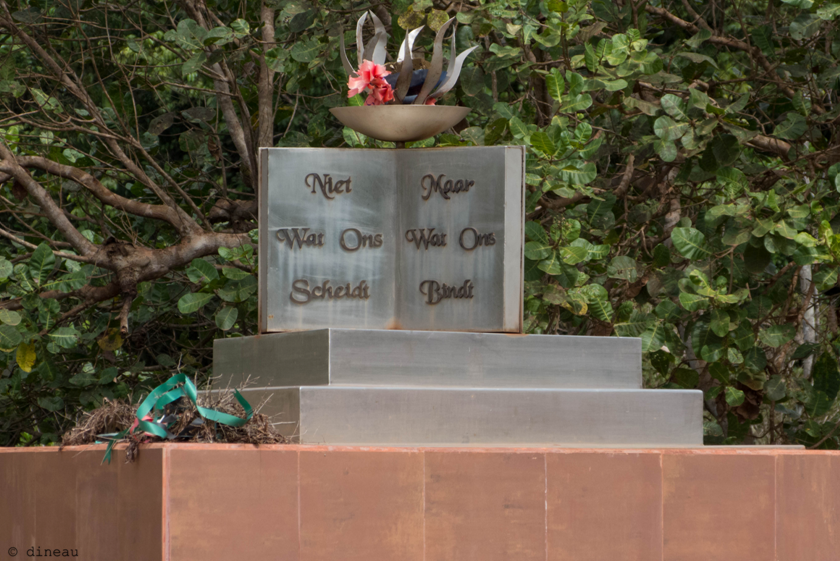Remembering the SLM DC-8 crash
25 years ago Surinam Airways DC-8-62H N1809E crashed near Zanderij, Parimaribo, Surinam
|
Last week I have visited the SLM DC-8 crash site near Zanderij Airport, Surinam. Enclosed the photo's of the site monument and the still remaining parts of wings and one of the JT3D-3B engines.
What happend 25 years ago! Surinam Airways Flight 764 was an international scheduled passenger flight from Amsterdam Airport Schiphol in the Netherlands to Paramaribo-Zanderij International Airport in Suriname on a Surinam Airways DC-8-62 registrated N1809E. On Wednesday, June 7, 1989, the flight crashed during approach to Paramaribo-Zanderij, killing 176 of the 187 on board. Investigation revealed significant deficiencies in the crew's training and judgement. They knowingly attempted to land using an inappropriate navigation signal and ignored alarms warning them of an impending crash. The aircraft was a four-engined McDonnell Douglas DC-8-62 passenger jet which had first flown in 1969 as part of the air fleet of Braniff International Airways. The flight departed Amsterdam Airport Schiphol as scheduled at 23:25 on June 6. The next ten hours of the flight passed uneventfully. The crew received a final weather report and clearance for a VOR/DME (VHF omnidirectional range/Distance Measuring Equipment) approach to runway 10 but instead initiated an ILS (Instrument Landing System/Distance Measuring Equipment) landing. During the approach, the plane's No. 2 engine struck a tree at a height of approximately 25 meters above ground level. The right wing then struck another tree, causing the aircraft to roll and impact the ground inverted. Of the 9 crew and 178 passengers, none of the crew and only 11 passengers survived, leaving 176 dead. A commission was set up by the Surinamese government to investigate the accident. The results of that investigation were: The final weather report sent to the aircraft accurately stated that there was visibility of 900 meters in dense fog, 1/4 cloud cover with a cloud base at 400 feet, and winds calm. This surprised the flight crew, because previous weather information had given visibility of 6 kilometers. As a result, despite the fact that the aircraft was cleared for a VOR/DME (VHF omnidirectional range/Distance Measuring Equipment) approach, it was an ILS/DME (Instrument Landing System/Distance Measuring Equipment) that was initiated. ILS navigational equipment is normally more accurate than VOR/DME equipment, but in this case the ILS equipment at Zanderij airport, though transmitting signals, was not suitable nor available for operational use. The investigation showed that the crewmembers were aware of this. The cockpit voice recorder captured the first officer saying, "I don't trust that ILS", but the captain chose to use it regardless. He did instruct the First Officer to tune the required navigational equipment for the functional VOR/DME approach, most likely for use as a gross error check. Because of the unreliability of the ILS signal, the aircraft descended too low, triggering several audible and visual warning signals. The crew ignored these warnings, and also descended below the minimum altitude allowed for both the VOR/DME and ILS procedures without positive visual contact with the runway. A possible reason was that they had to land soon due to a lack of fuel, until finally, the aircraft crashed at 04:27. The NTSB investigation also turned out that the captain was 66 years old which was over the maximum age allowed for operating as captain on this flight. Additionally he was not properly checked and approved for operation on the aircraft type, as his most recent check had been done on a small piston twin engined aircraft instead of the DC-8. Partly due to name confusion in his check paperwork, this incorrect check went unnoticed by the airline. The probable cause paragraph from the report reads as follows: The Commission determines: a) That as a result of the captain's glaring carelessness and recklessness the aircraft was flown below the published minimum altitudes during the approach and consequently collided with a tree. b) As underlying factor in the accident was the failure of SLM's (Surinam Airways) operational management to observe the pertinent regulations as well as the procedures prescribed in the SLM Operations Manual concerning qualification and certification during recruitment and employment of the crew members furnished by ACI. Information with the Photo’s: · N1809E by Perry Hoppe. · The monument. · The jungle road leading to the monument. · One of the JT3D-3B lingers on the crash site. · Part of the wing is still burried on the sand at the crash site. · So damn close to the safety of the runway! |
|







